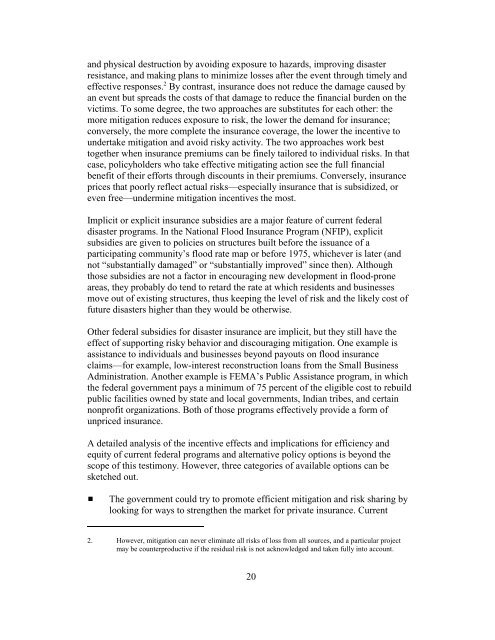Macroeconomic and Budgetary Effects of Hurricanes Katrina and Rita
Macroeconomic and Budgetary Effects of Hurricanes Katrina and Rita
Macroeconomic and Budgetary Effects of Hurricanes Katrina and Rita
You also want an ePaper? Increase the reach of your titles
YUMPU automatically turns print PDFs into web optimized ePapers that Google loves.
<strong>and</strong> physical destruction by avoiding exposure to hazards, improving disaster<br />
resistance, <strong>and</strong> making plans to minimize losses after the event through timely <strong>and</strong><br />
effective responses. 2 By contrast, insurance does not reduce the damage caused by<br />
an event but spreads the costs <strong>of</strong> that damage to reduce the financial burden on the<br />
victims. To some degree, the two approaches are substitutes for each other: the<br />
more mitigation reduces exposure to risk, the lower the dem<strong>and</strong> for insurance;<br />
conversely, the more complete the insurance coverage, the lower the incentive to<br />
undertake mitigation <strong>and</strong> avoid risky activity. The two approaches work best<br />
together when insurance premiums can be finely tailored to individual risks. In that<br />
case, policyholders who take effective mitigating action see the full financial<br />
benefit <strong>of</strong> their efforts through discounts in their premiums. Conversely, insurance<br />
prices that poorly reflect actual risks—especially insurance that is subsidized, or<br />
even free—undermine mitigation incentives the most.<br />
Implicit or explicit insurance subsidies are a major feature <strong>of</strong> current federal<br />
disaster programs. In the National Flood Insurance Program (NFIP), explicit<br />
subsidies are given to policies on structures built before the issuance <strong>of</strong> a<br />
participating community’s flood rate map or before 1975, whichever is later (<strong>and</strong><br />
not “substantially damaged” or “substantially improved” since then). Although<br />
those subsidies are not a factor in encouraging new development in flood-prone<br />
areas, they probably do tend to retard the rate at which residents <strong>and</strong> businesses<br />
move out <strong>of</strong> existing structures, thus keeping the level <strong>of</strong> risk <strong>and</strong> the likely cost <strong>of</strong><br />
future disasters higher than they would be otherwise.<br />
Other federal subsidies for disaster insurance are implicit, but they still have the<br />
effect <strong>of</strong> supporting risky behavior <strong>and</strong> discouraging mitigation. One example is<br />
assistance to individuals <strong>and</strong> businesses beyond payouts on flood insurance<br />
claims—for example, low-interest reconstruction loans from the Small Business<br />
Administration. Another example is FEMA’s Public Assistance program, in which<br />
the federal government pays a minimum <strong>of</strong> 75 percent <strong>of</strong> the eligible cost to rebuild<br />
public facilities owned by state <strong>and</strong> local governments, Indian tribes, <strong>and</strong> certain<br />
nonpr<strong>of</strong>it organizations. Both <strong>of</strong> those programs effectively provide a form <strong>of</strong><br />
unpriced insurance.<br />
A detailed analysis <strong>of</strong> the incentive effects <strong>and</strong> implications for efficiency <strong>and</strong><br />
equity <strong>of</strong> current federal programs <strong>and</strong> alternative policy options is beyond the<br />
scope <strong>of</strong> this testimony. However, three categories <strong>of</strong> available options can be<br />
sketched out.<br />
# The government could try to promote efficient mitigation <strong>and</strong> risk sharing by<br />
looking for ways to strengthen the market for private insurance. Current<br />
2. However, mitigation can never eliminate all risks <strong>of</strong> loss from all sources, <strong>and</strong> a particular project<br />
may be counterproductive if the residual risk is not acknowledged <strong>and</strong> taken fully into account.<br />
20
















